Music and art classes offer you creative outlets that boost your academic performance, enhance emotional well-being, and develop essential career skills. Engaging in these classes can improve your literacy, problem-solving, and collaboration abilities. They also provide a space for self-expression and connection with others, fostering a sense of community. Plus, you’ll explore diverse learning styles and the importance of access in arts education. Keep going to discover more about the benefits and opportunities in these artistic domains!
Key Takeaways
- Music and art classes enhance academic performance, boosting grades in subjects like math and language arts through creative engagement.
- Participation in these classes nurtures emotional expression, improving mental well-being and fostering a sense of community among students.
- Arts education accommodates diverse learning styles, ensuring inclusivity for visual, auditory, and kinesthetic learners through varied teaching methods.
- Students develop essential skills through arts, including creativity, teamwork, problem-solving, and communication, which are highly valued in the workforce.
- Access to music and art programs promotes equity, especially in underserved communities, bridging cultural gaps and enhancing social dialogue through shared artistic experiences.
Academic Advantages of Arts Education
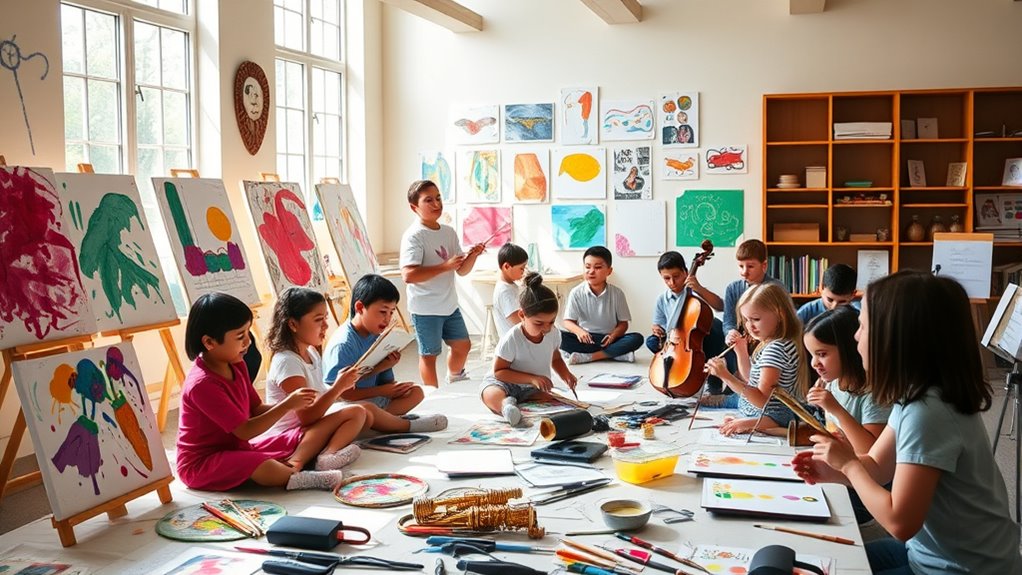
When you consider the benefits of arts education, one of the most significant is its positive impact on academic achievement. Engaging in music and art classes not only enhances your literacy and language skills but also boosts your overall academic performance. Students involved in these subjects tend to achieve higher grades across various disciplines, including math and language arts. In addition, visual arts, like drawing and painting, sharpen your visual-spatial skills, essential for interpreting information. Participation in arts classes can also lead to increased motivation, which often results in higher attendance rates and increased engagement in school. Ultimately, arts education equips you with critical thinking skills, allowing you to analyze complex information and make informed decisions, benefiting both your academics and personal growth. Furthermore, engaging in creative outlets fosters self-care practices, which can enhance mental clarity and emotional well-being. This creative engagement also supports emotional regulation, promoting resilience and healthier responses to stressors in other areas of life. Additionally, positive thinking strategies can enhance personal development by encouraging a proactive mindset that translates into academic success. Engaging in creative practices can also lead to enhanced problem-solving skills, which are essential for navigating challenges both in school and in everyday life. Moreover, the transformative power of curiosity can spark creativity and fuel personal growth, further enriching the educational experience.
Emotional and Psychological Impact of Music
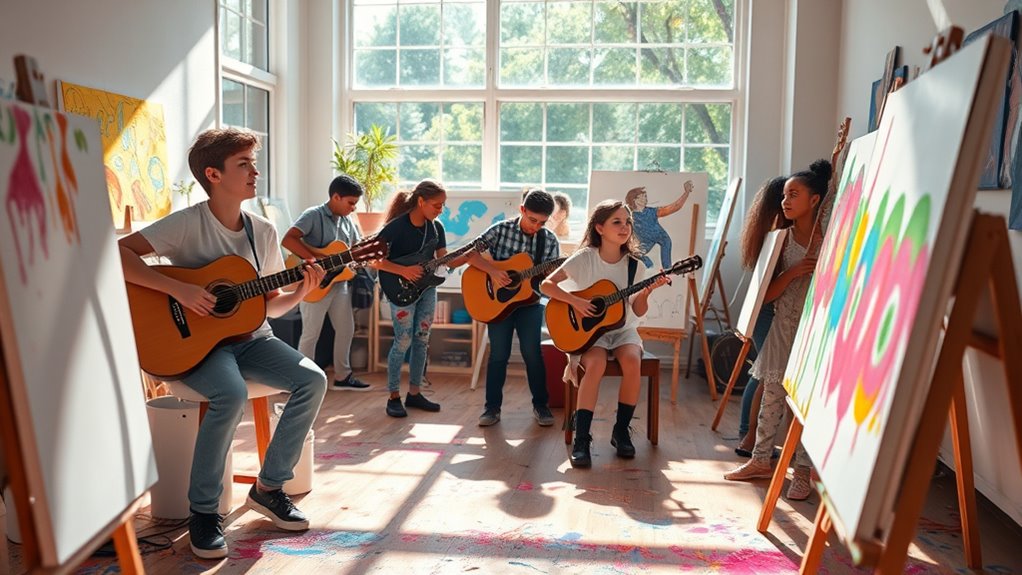
Music possesses a unique power to influence your emotional and psychological well-being. It acts as a powerful outlet for expressing and processing emotions essential for mental health. Engaging in music raises dopamine levels, enhancing your mood and pleasure. Moreover, boosting libido with vitamins can also contribute to improved emotional health, showcasing the interconnectedness of various aspects of well-being. Additionally, music often reflects themes of uncertainty and longing in love, further illustrating its ability to resonate with personal experiences. Regular nighttime meditation can enhance the emotional benefits of music by promoting relaxation and a positive mindset.
Music uniquely influences emotional and psychological well-being, acting as a vital outlet for processing essential emotions.
The Iso-principle allows you to match music with your current feelings, helping shift your emotions as needed. Listening to music can ease anxiety, lower blood pressure, and improve sleep quality. Additionally, music can reduce anxiety and improve post-surgery outcomes, showcasing its healing potential. Research shows that sound therapy can alleviate symptoms of anxiety and depression, further emphasizing music’s therapeutic benefits.
Active music-making boosts self-esteem and motivation while stimulating brain regions tied to reward and emotion. For those feeling stressed or isolated, music serves as a therapeutic tool, promoting emotional release and regulation. Furthermore, engaging with music can lead to enhanced cognitive function and memory retention, ultimately enriching your life and fostering resilience and emotional health.
Diverse Learning Styles Supported by Arts

Art classes provide an inclusive environment that caters to diverse learning styles, ensuring every student can thrive.
Visual learners benefit from vibrant colors and compositions, while auditory learners engage through discussions and storytelling. If you’re a kinesthetic learner, hands-on activities allow you to physically interact with materials, enhancing your experience. Tactile learners also thrive with varied textures, making sensory engagement essential. By incorporating a multisensory approach, art classes embrace all learning styles. Multi-sensory experiences cater to various learning styles and preferences, further enriching the creative process. Additionally, engaging in creative activities has been shown to enhance cognitive functions such as memory consolidation, which can be beneficial for all learners. Furthermore, the use of Waldorf toys promotes imaginative play that supports problem-solving skills, enhancing cognitive development. Moreover, these activities can also improve customer satisfaction by fostering a more engaging learning environment. Educational toys, like Montessori Busy Books, can provide additional support for cognitive development in young children. Furthermore, participating in creative outlets can boost socialization skills, which are important for building relationships and confidence.
Differentiated instruction and flexible learning environments further support individual needs, allowing you to explore your creativity in ways that resonate with you.
With varied activities, such as group projects or solo work, you’ll find the perfect outlet to express yourself and excel academically.
Addressing Access and Equity in Arts Programs
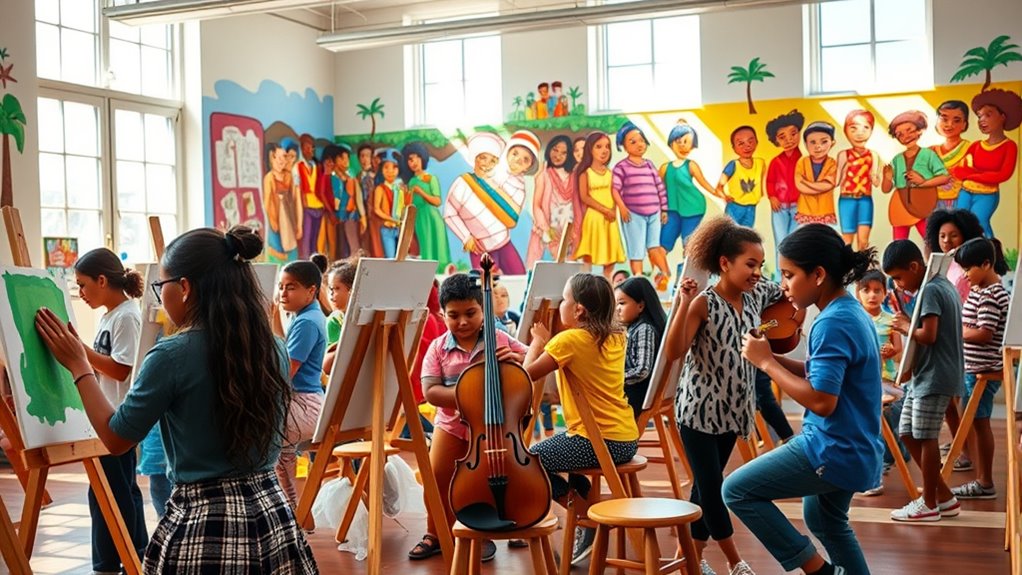
Access to arts programs greatly impacts students’ educational experiences, especially for those in underserved communities. Unfortunately, millions of students, particularly in urban areas and those eligible for free/reduced meals, lack access to music education. 92% of students have access to music education; however, 3,609,698 do not. Black and Hispanic students face significant disparities, with reductions in arts education since the 80s. Schools with high minority populations often receive less funding, affecting program availability. The COVID-19 pandemic worsened these issues, leading to budget cuts. However, organizations like Arts Corps are working to bridge these gaps by providing arts experiences to thousands of students each year. It is essential to recognize that emotional expression through activities can greatly enhance children’s well-being and resilience during challenging times, as celebrating relationships fosters a supportive environment for growth.
Career Skills Developed Through Arts Education
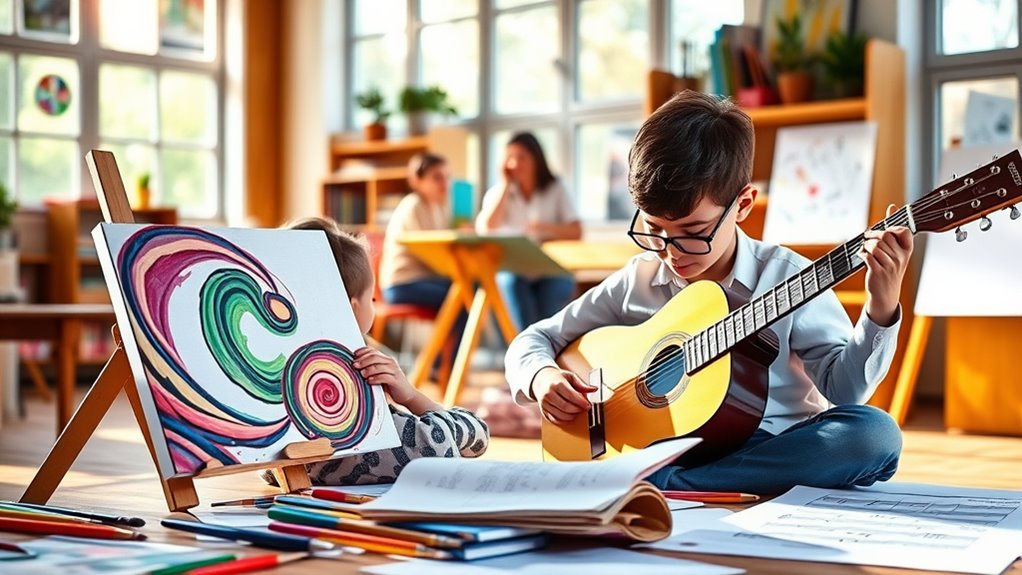
While many might view arts education as merely a creative outlet, it actually equips students with essential career skills that are highly sought after in today’s workforce. Engaging in arts fosters your creativity, making you a better problem solver. Additionally, participating in STEM education enhances critical thinking skills through interactive play. Furthermore, the ability to adapt and embrace sustainable fashion trends can enhance your creativity and open new career pathways. This adaptability is essential in fields like interior design, where functional layouts must be created to meet diverse client needs. The integration of AI technologies is also expected to revolutionize various industries, providing new opportunities for creative professionals.
You’ll find yourself thinking flexibly and adapting to various challenges. Collaborative projects in the arts enhance your teamwork and communication skills, allowing you to express ideas effectively. Research findings have shown that students involved in arts are three times more likely to hold class office. Moreover, strong communication skills gained through arts education help you build rapport and clarity in professional settings.
As you create, you’ll develop critical thinking abilities, analyze information, and tackle complex problems with persistence. Additionally, arts education nurtures emotional intelligence, helping you manage feelings and build empathy.
Ultimately, these skills prepare you for dynamic work environments, making you a valuable asset to any employer.
Public Perception of Arts in Education
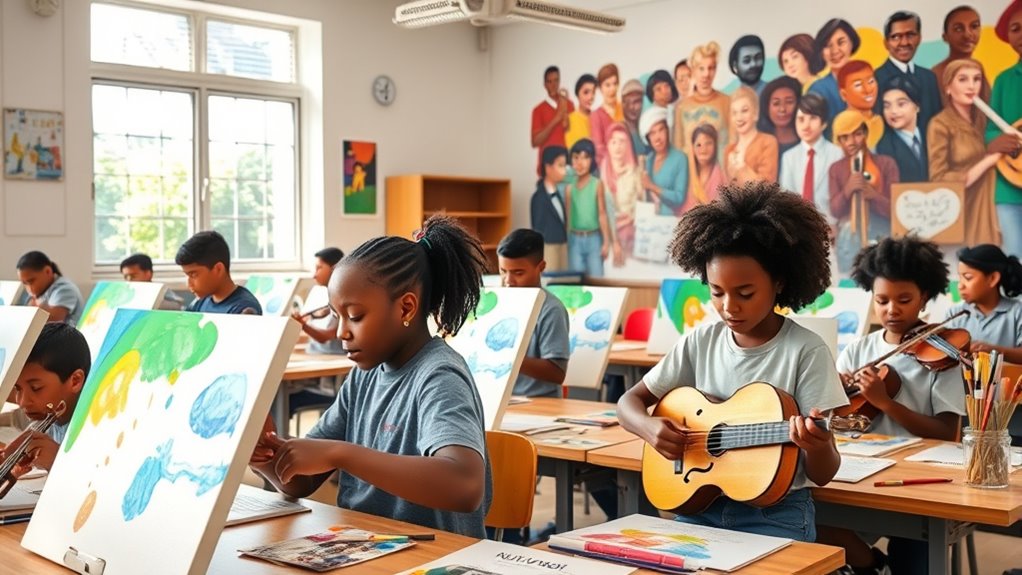
As public awareness of the importance of a well-rounded education grows, support for arts education remains robust across various demographics. An impressive 92% of American adults believe arts education is essential for students at all grade levels, transcending political lines. People recognize that the arts aren’t just supplementary; 91% see them as critical for a thorough education. Many also believe that arts participation enhances academic performance—70% agree it boosts student outcomes. However, despite this strong support, over two million students, particularly in underserved communities, lack access to arts education. This disparity highlights the need for advocacy and funding, ensuring all students, regardless of background, can benefit from the enriching experiences that arts education offers. Additionally, proper disposal methods for art materials can contribute to environmental sustainability within educational settings. Engaging with life-changing quotes can inspire both educators and students to value creativity in their learning journeys. Supporting arts education can also help combat feelings of isolation among students, fostering a sense of community and connection.
Community Engagement Through Arts Initiatives
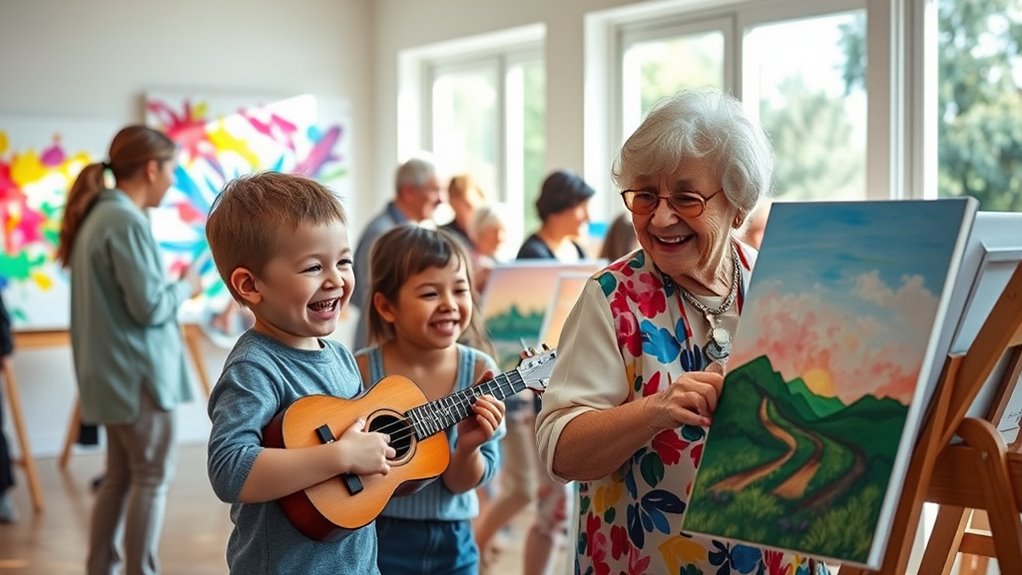
Engaging with arts initiatives not only enriches individual lives but also strengthens community ties. By participating in local arts activities, you foster connections and build social bonds.
These initiatives provide a platform for emotional expression, essential for mental well-being. You might find joy in collaborative projects, like community murals, that invite everyone to contribute their creativity.
Events such as art walks and cultural festivals not only showcase local talent but also promote inclusivity, allowing diverse voices to be heard.
Additionally, arts initiatives spark social dialogue, bridging cultural gaps and enhancing understanding among community members.
Through these creative outlets, you play a significant role in cultivating a vibrant, cohesive community that celebrates its unique identity and shared experiences.
Legislative Support for Arts Funding
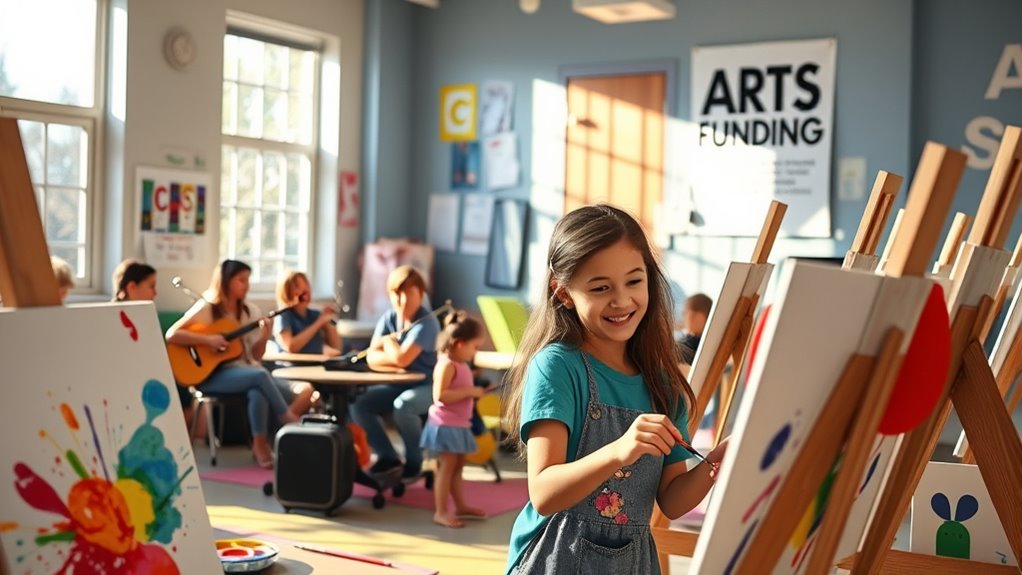
Community engagement through arts initiatives is deeply intertwined with the need for legislative support that champions arts funding. By advocating for the Arts Education for All Act and robust funding for the National Endowment for the Arts, you can help guarantee arts education thrives in schools.
Legislative measures like the Performing Artist Tax Parity Act and the Creative Workforce Investment Act empower artists while boosting local economies. Supporting the STAR Act integrates art into essential projects, enhancing community identity.
Through grants and dedicated revenue strategies, you can access crucial resources for arts programs. Your involvement in grassroots advocacy can make a difference, making sure diverse communities benefit from equitable access to the transformative power of the arts.
Frequently Asked Questions
How Can Parents Support Their Child’s Interest in Arts Education?
To support your child’s interest in arts education, start by creating a dedicated workspace for their creative activities.
Encourage them to explore different art forms and utilize online resources to enhance their skills.
Incorporate artistic activities into your daily routine, like singing or drawing together.
Get involved in local art events and advocate for strong arts programs in your community, ensuring they’ve access to a rich and diverse arts education.
What Types of Arts Programs Are Available in Schools?
You’ll find several types of arts programs in schools, including Art as Curriculum, which teaches specific art forms like music and theater.
Arts-Enhanced Curriculum uses art to boost engagement in traditional subjects without focusing on artistic skills.
Finally, Arts-Integrated Curriculum combines art with other subjects, promoting critical thinking.
Each program varies in availability and structure, but they all aim to enrich students’ educational experiences and foster creativity.
Are There Online Resources for Learning Music or Art?
Yes, there’re plenty of online resources for learning music and art. You can explore platforms like MusicplayOnline for interactive music lessons or Berklee Shares for free courses.
If you’re interested in art, check out Free Art Tutorials for painting tips or digital art software for creative projects.
Communities on social media and forums also provide great spaces for sharing your work and receiving feedback. Immerse yourself and let your creativity flourish!
How Do Arts Classes Fit Into a Busy School Schedule?
Arts classes can fit into your busy school schedule through flexible options and effective time management. Many programs offer after-school sessions or weekend classes, allowing you to pursue your interests without overwhelming your academic load.
You can also find arts integrated into core subjects, making learning more engaging. By prioritizing these creative outlets, you enhance your overall education while balancing your commitments, ensuring you stay motivated and inspired throughout your school day.
What Are Some Common Misconceptions About Arts Education?
Imagine a vibrant garden where every flower represents a different subject. Many think of arts as mere decorative blooms, non-essential to the garden’s health.
You might hear that arts require extensive training or lack real-world value, but that’s simply not true. Each art form offers unique skills and fosters creativity, teamwork, and cultural appreciation.
Conclusion
To sum up, music and art classes aren’t just extracurricular; they’re essential threads in the fabric of education. By embracing these creative outlets, you’re not only enriching your mind but also nurturing your emotional well-being. Think of arts education as a bridge, connecting diverse learning styles and fostering community engagement. As you advocate for continued support and funding, remember that every note and brushstroke contributes to a vibrant future, ensuring everyone has access to the transformative power of creativity.









